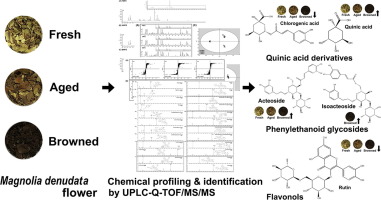Food Research International ( IF 7.0 ) Pub Date : 2020-03-19 , DOI: 10.1016/j.foodres.2020.109192 Yong Hoon Joo 1 , Myung Hee Nam 2 , Namhyun Chung 1 , Yong Kwon Lee 3

|
The Magnolia denudata flower is used to prepare tea and is often fermented to improve its flavor. Herein, fresh, aged, and browned M. denudata flower extracts were characterized using ultra performance liquid chromatography coupled with a hybrid quadrupole orthogonal time-of-flight mass spectrometer (UPLC-Q-TOF/MS/MS). The 1,223 and 458 mass ions of ESI+ and ESI− modes that were significantly changed by the fermentation process were selected using three criteria. Sixteen compounds including flavonoids, phenylethanoid glycoside derivatives (PhGs), caffeoylquinic acids (CQAs), and others were identified based on their accurate mass and MS/MS spectra and analyzed as the main chemical components. The levels of the main chemical components changed after fermentation. The comparative quantity and composition of the phytochemicals differed for the three extract types. For example, flavonols were affected by fermentation, resulting in an increase or decrease (fold change value of negative ion: rutin -0.47; keioside 1.00). The CQAs were low during fermentation (1-CQA, -1.62; chlorogenic acid, -1.48). However, the quinic acid content was significantly high (quinic acid, 1.36). Isomers of PhGs like isoverbasoside and isoacteoside were produced during fermentation (isoverbasoside, 5.42; isoacteoside, B 3.33). These observations may provide a basis for studying the physiological effects of non-fermented and fermented M. denudata flower.
中文翻译:

UPLC-QTOF-MS / MS筛选和鉴定新鲜,陈年和褐变的玉兰花提取物中的生物活性化合物。
在玉兰花是用来准备茶水和通常发酵,以提高它的味道。在此,新鲜,陈年和褐变的天竺葵使用超高效液相色谱与混合四极杆正交飞行时间质谱仪(UPLC-Q-TOF / MS / MS)对花提取物进行表征。使用三个标准选择了在发酵过程中显着改变的ESI +和ESI-模式的1,223和458质量离子。根据准确的质量数和MS / MS谱图鉴定了16种化合物,包括类黄酮,苯乙醛糖苷衍生物(PhGs),咖啡酰奎尼酸(CQAs)等,并将其分析为主要化学成分。发酵后主要化学成分的水平发生了变化。三种提取物类型的植物化学物质的比较量和组成有所不同。例如,黄酮醇受到发酵的影响,导致增加或减少(负离子倍数变化值:芦丁-0.47; keioside 1.00)。发酵过程中的CQA较低(1-CQA,-1.62;绿原酸,-1.48)。但是,奎宁酸含量非常高(奎宁酸1.36)。在发酵过程中产生了PhG的异构体,如异佛手苷和异乳糖苷(异佛手苷,5.42;异乳糖苷,B 3.33)。这些观察结果可为研究非发酵和发酵的生理效应提供基础。M. denudata花。











































 京公网安备 11010802027423号
京公网安备 11010802027423号